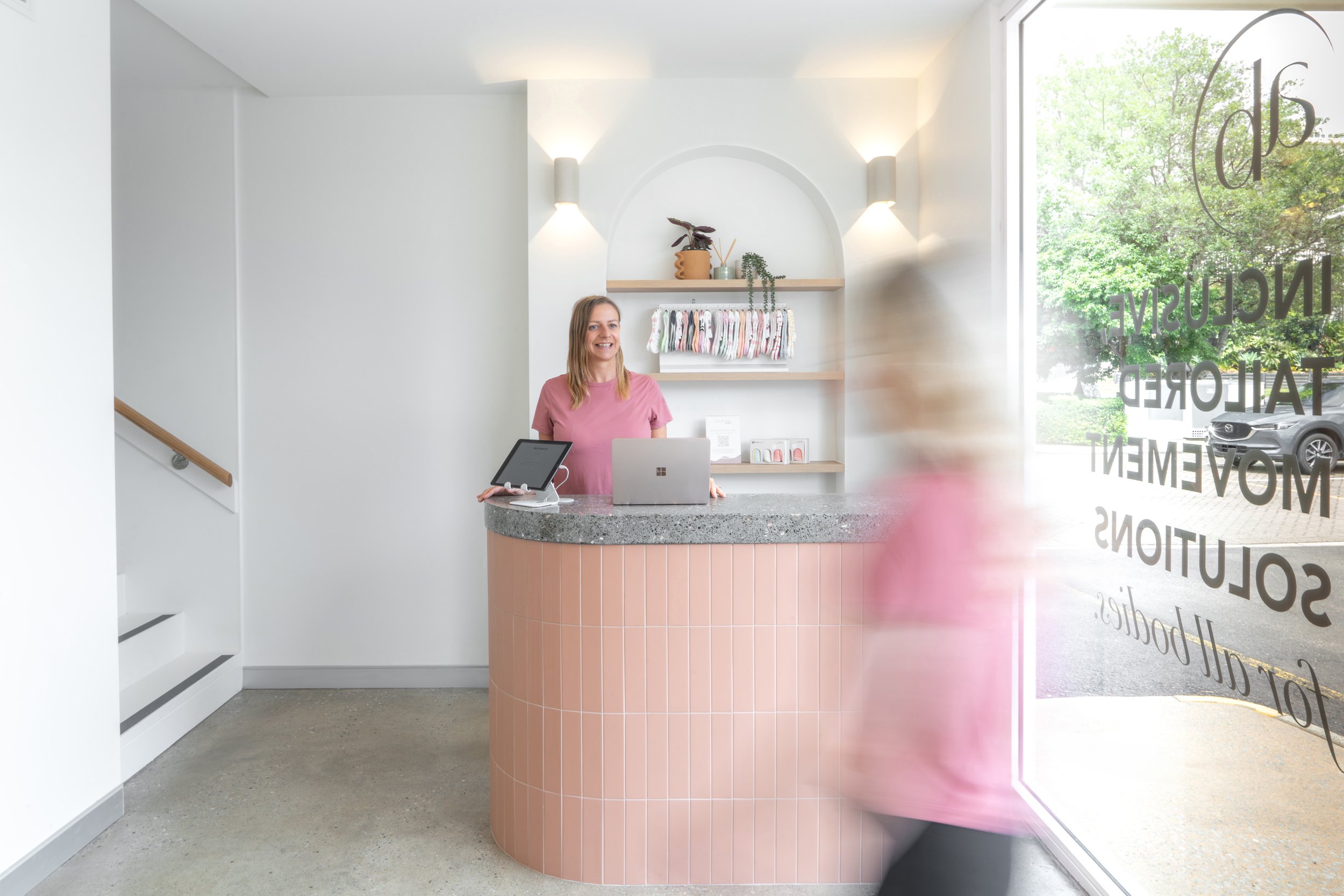
Evidence-informed care for women’s health & complex conditions
We specialise in endometriosis, perimenopause/menopause, hypermobility spectrum disorders (incl. EDS), POTS, complex pain, and osteoporosis. Our approach blends joint variability, strength, breathwork, and pacing — tailored by Accredited Exercise Physiologists.
Endometriosis
Strategies to reduce pain & fatigue with joint variability, strength dosing, and nervous system support.
Hypermobility / EDS
Stability over stretching: graded loading, proprioception, breath & pacing for sustainable progress.
Perimenopause
Strength & impact tolerance, recovery rituals, and energy-aware programming for symptom support.
POTS
Recumbent starts, tolerance ladders, breath-led tempo, and careful progression to upright tasks.
Osteoporosis
Safe loading, impact options, posture & balance work — graded for confidence and bone stimulus.
Complex Pain
Education, graded exposure, variability & down-regulation to de-threaten movement.
Exercise & Endometriosis — what helps, what hurts
Snapshot
Exercise supports circulation, pain modulation, hormones, and confidence. With endometriosis, baseline inflammation and fatigue can be higher — so success relies on joint variability, smart dosing, and down-regulation.
How we help
- Build joint variability: rotate, side-bend, change angles to spread load.
- Strength with breath: sync breath to effort to manage pressure.
- Gentle mobility: slow, controlled work for hips, pelvis, lower back.
- Pacing: shorter, consistent sessions > boom-and-bust cycles.
Generally helpful
- Low–moderate strength (reformer, bands, bodyweight)
- Breath-led tempo & down-regulation
- Rotation & asymmetry where tolerated
Modify / avoid during flares
- High-intensity/impact blocks without build-up
- Excessive abdominal compression (long planks, breath-holding)
- Rigid, repetitive routines in one plane only
FAQs
Does exercise increase inflammation?
Exercise creates a small, adaptive inflammatory signal. With endo, your baseline may be higher, so we dose carefully and prioritise recovery.
Why am I so fatigued after exercise?
Fatigue and inflammation are linked. We use pacing, breath, and variability to reduce total inflammatory load and improve recovery.
Is Clinical Pilates right for me?
Yes — especially when tailored by an EP. We emphasise variability, safe strength, and symptom-aware progressions.
Ready for personalised support? Book a 1:1 EP consult or 1:3 Clinical Pilates.
More than “flexible joints” — understanding the whole picture
Core principle
Avoiding movement isn’t the answer. We get why it seems that way — for many, movement has equalled injuries. The key is learning how to move: understanding your compensation patterns, building joint variability, and dosing strength at tolerable levels. That’s how we reduce flare risk and find long-term success.
Snapshot
Hypermobility spectrum disorders and EDS aren’t just about “too much range.” They often present with co-morbidities such as POTS, mast cell activation (MCAS), thermoregulation issues, complex pain syndromes, GI involvement, and fatigue. Effective care requires systems thinking — not just joint-by-joint exercise prescription. We prioritise movement literacy (identifying and re-patterning compensations) over “more stretching.”
How we help
- Compensation mapping → options: we assess common “go-to” patterns and coach safer alternatives to share load through more joint angles.
- Stability & load tolerance: graded closed-chain strength, proprioception drills, tempo control.
- Braces, crutches & supports: we integrate assistive devices into programs and plan safe weaning/progression when appropriate.
- Compression & circulation: garments/stockings to support venous return and exercise tolerance.
- Thermoregulation: adjust environment, hydration, cooling, and session density for dysautonomia/heat issues.
- Complex pain: nervous-system education, down-regulation, and careful exposure to new loads/movements.
Generally helpful
- Slow, controlled resistance with external feedback (mirrors, tactile cues)
- Breath-led tempo and stacking drills to manage pressure
- Reformer variability with thoughtful spring selection
- Compression garments; proactive cooling & hydration strategies
Modify / avoid
- Over-stretching already lax joints
- Early high-velocity impact/plyometrics without foundations
- Ignoring fatigue/autonomic red flags (dizziness, overheating)
- “Push through pain” approaches that reinforce sensitisation
FAQs
Why do I keep getting injured — should I just stop moving?
Stopping feels safer short-term, but it reduces capacity and confidence. Success comes from learning how to move: identify compensations, build variability, and dose strength you can recover from.
Do you work with braces, crutches and compression?
Yes. We clarify each aid’s role (stability, off-load, circulation), build programs around them, and plan progression if/when appropriate.
What about POTS, MCAS or GI issues?
Common co-morbidities. We adapt for hydration/salt, compression, pacing, and trigger awareness — with a whole-system lens.
Is it safe to load lax joints?
With careful coaching and dosing, controlled loading is protective. We prioritise tempo, feedback, and gradual variability to build tolerance without flares.
Thermoregulation is a problem — how do you manage that?
Session structure (shorter bouts, longer rests), cooling strategies, environment tweaks, and breath pacing help maintain tolerance on hot or challenging days.
We see the whole picture. Learn how to move — not avoid movement. We’ll map compensations, build variability, and load safely for real-world resilience.
Strength, recovery, and energy-aware programming
Snapshot
Hormonal shifts can affect sleep, thermoregulation, mood, and connective tissues. Evidence supports progressive strength, impact tolerance (as appropriate), and aerobic work to improve symptoms, bone health and metabolic resilience. We dose load with your energy and recovery in mind.
How we help
- Progressive strength: 2–3×/week, focus on big patterns (squat, hinge, push, pull).
- Impact options (graded): skipping drills, step drops, or pogo progressions for bone.
- Aerobic conditioning: zone-2 baseline with short, tolerable surges.
- Recovery rituals: breathwork, down-regulation, sleep hygiene tips.
Generally helpful
- Strength blocks (6–12 reps) with progressive overload
- Reformer for control, mobility, and tempo
- Zone-2 cardio (talk pace) 20–40 mins
Modify / avoid
- Excessive HIIT when sleep or hot flushes are high
- Random intensity without recovery planning
- High impact without a graded runway
FAQs
Will lifting weights make symptoms worse?
Done progressively, strength training often improves sleep, mood, and body composition — and supports bone health.
Do I need impact exercise?
Some impact helps bone, but we grade it. If impact isn’t tolerable now, we start with strength and low-impact load.
How do you handle low-energy weeks?
We flex volume/tempo and emphasise recovery practices so you can stay consistent without crashing.
Ready to build confident strength? Start with a 1:1 EP consult or join Strength & Reformer pathways.
From recumbent capacity to upright tolerance
Snapshot
POTS requires careful autonomic loading. We build capacity with recumbent and semi-recumbent work first, then progress to upright tasks using tolerance ladders, breath pacing, and symptom-aware monitoring.
How we help
- Recumbent starts: bike/row/reformer with short, repeatable bouts.
- Compression, fluids, salt education alongside exercise where appropriate.
- Breath-paced strength: closed-chain patterns at controlled tempo.
- Upright progression: graded sit-to-stand, march, walk, and carry ladders.
Generally helpful
- Intervals 1–3 mins with equal/rested recovery
- Lower-body strength (glutes/hamstrings) to support venous return
- Breathing drills for rate/CO2 control
Modify / avoid
- Sudden jumps to upright, long static standing
- Heat/exertion spikes without hydration & cooling plan
- Breath-holding/bracing under load
FAQs
Is cardio safe with POTS?
Yes when dosed well. We start recumbent and progress volume/intensity gradually based on tolerance.
What if I crash after sessions?
We adjust bout length, recovery, temperature, fluids/salt, and use stricter pacing with symptom logs.
Can I do Reformer?
Yes — it’s a great recumbent tool. We control springs, tempo, and transitions to manage autonomic load.
Build capacity safely. Start recumbent, progress to upright — with an EP guiding each step.
Bone-smart strength, impact, balance & posture
Snapshot
Exercise is a cornerstone for bone health. We combine progressive resistance, graded impact (as suitable), and balance/posture drills to improve bone stimulus and reduce fall risk — all tailored to your DEXA, history, and confidence.
How we help
- Strength: spine/hip loading with safe technique and progressive overload.
- Impact options: step drops, footwork hops, or loaded carries (graded).
- Balance & posture: stance progressions, gait drills, anti-flexion strategies.
- Education: movement confidence for daily tasks and hobbies.
Generally helpful
- Deadlifts/hinges, squats, step-ups, rows, presses
- Loaded carries & posture holds (as tolerable)
- Balance ladders (narrow stance → single-leg)
Modify / avoid
- End-range loaded spinal flexion/twisting
- High impact without a graded entry
- Fast tempo without control and coaching
FAQs
Is impact safe with low bone density?
Often yes — when graded. We select entry-level options and progress based on confidence, balance, and medical guidance.
Can I lift weights with osteoporosis?
Yes. We prioritise form, tempo, and tolerance. Progressive loading is beneficial when coached appropriately.
What about spine safety?
We avoid end-range loaded flexion and train posture/strength to support daily living tasks confidently.
Bone-smart training starts here. Build strength, balance and confidence with an EP.
FREE E-BOOKS
Navigating Postpartum Pelvic Floor Dysfunction
A comprehensive approach to movement + healing by women’s health exercise physiologists
The Role of Exercise in Managing symptoms of Perimenopause & Menopause
A practical guide to Movement, Strength & Improved Quality of life.
Empowered Movement: A Guide to Ehlers-Danlos Syndrome (EDS) and Safe, Supportive Exercise
any.BODY Approach to Movement for EDS






